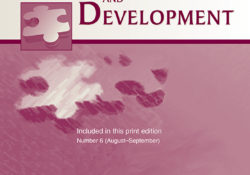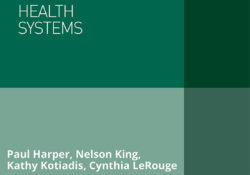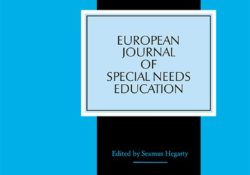tandfonline.com har udgivet en rapport under søgningen “Teacher Education Mathematics”: The Effects of COVID-19 on Young Children’s and Their Parents’ Activities at Home Link til kilde
Like this:
Like Loading...
tandfonline.com har udgivet en rapport under søgningen “Teacher Education Mathematics”: Abstract Educational disruption due to COVID-19 ushered in dramatically different learning realities in Ireland. Our research explored the experiences of children, young people and parents during the first period of ‘schooling at home’ (SAH) at the end of that academic year. An anonymous online survey, guided by social constructivist emphases, yielded responses from 2733 parents and 1189 students from primary and second-level schools. Substantial evidence emerged of parent-perceived and student-perceived negative psychosocial impacts of SAH on students. Further, our research clarified the exceptional stress experienced by parents in attempting to support SAH. A novel finding was student perceptions of having learned less during SAH, most likely due to significant declines in academic engagement. Recommendations for potential future periods of SAH… Continue Reading →
Like this:
Like Loading...
tandfonline.com har udgivet en rapport under søgningen “Teacher Education Mathematics”: ABSTRACT Formulae display:?Mathematical formulae have been encoded as MathML and are displayed in this HTML version using MathJax in order to improve their display. Uncheck the box to turn MathJax off. This feature requires Javascript. Click on a formula to zoom. ABSTRACT We provide an open-source model to estimate the number of secondary Covid-19 infections caused by potentially infectious students returning from university to private homes with other occupants. Using a Monte-Carlo method and data derived from UK sources, we predict that an infectious student would, on average, infect 0.94 other household members. Or, as a rule of thumb, each infected student would generate (just less than) one secondary within-household infection. The total number of secondary cases for all returning… Continue Reading →
Like this:
Like Loading...
tandfonline.com har udgivet en rapport under søgningen “Teacher Education Mathematics”: ABSTRACT ABSTRACT School closures due to the worldwide COVID-19 pandemic put challenges on teachers, students and their parents. In particular, students with special educational needs or students with low achievement levels who need more support in learning may have more difficulties coping compared to their peers. Using longitudinal data of the German National Educational Panel Study, the circumstances of students in secondary school during the time of school closures are characterised, in particular focusing on students who have been diagnosed with special educational needs or showing low achievement levels at the end of primary school. Overall, parents of students with special educational needs or low achievement levels do not report more challenges with respect to the situation of learning at… Continue Reading →
Like this:
Like Loading...
tandfonline.com har udgivet en rapport under søgningen “Teacher Education Mathematics”: ABSTRACT ABSTRACT Background: Children with disabilities are more likely to experience violence or injury at school and at home, but there is little evidence from Central Asia. Objective: To describe the prevalence of disability and associations with peer violence perpetration and victimization, depression, corporal punishment, school performance and school attendance, among middle school children in Pakistan and Afghanistan. Method: This is a secondary analysis of data gathered in the course of evaluations of interventions to prevent peer violence conducted in Pakistan and Afghanistan as part of the ‘What Works to Prevent Violence against Women and Girls Global Programme’. In Pakistan, the research was conducted in 40 schools, and disability was assessed at midline in 1516 interviews with Grade 7s. In… Continue Reading →
Like this:
Like Loading...
eric.ed.gov har udgivet: This guide was written to aid home economics teachers in developing a greater understanding and use of basic skills in the home economics curriculum. The objectives of this guide are (1) to expand the awareness of underlying mathematics and science principles in the consumer and vocational home economics curriculum and (2) to provide a bank of resources to give teachers a practical and useful base from which to launch their own basic skills instruction. The curriculum guide, structured around the Montana Scope and Sequence, is divided into the curriculum areas of child development, family life, clothing and textiles, foods and nutrition, consumer education, and housing and home furnishings. Objectives and page numbers corresponding to the Scope and Sequence are noted on the top of each page. Science… Continue Reading →
Like this:
Like Loading...
tandfonline.com har udgivet en rapport under søgningen “Teacher Education Mathematics”: Link til kilde
Like this:
Like Loading...
eric.ed.gov har udgivet: The idea of using plastic bottle caps to enhance children’s literacy and math skills was introduced in a pre-kindergarten methods and field class at West Chester University. We wanted an essentially cost-free way to create fun, hands-on, educational games for young students to learn basic skills supporting the Common Core State Standards (adopted by 45 states, www.corestandards.org/in-the-states). University education students began bringing plastic bottle caps, packaging them into kits, and taking them into local schools to help children learn. We have now not only formalized the Cap Kits program, but we have also conducted dozens of teacher trainings and parent workshops and have given away thousands of Cap Kits. By placing these materials into the hands of children, we are giving them manipulatives that can be used… Continue Reading →
Like this:
Like Loading...
eric.ed.gov har udgivet: Turning everyday activities such as baking into scientific activities is more than just fun: it is important for our children’s futures. Science investigations provide an opportunity for children to learn about scientific concepts and listen to their peers, family, and community members, and to respond to their questions or ideas. It also provides them with an opportunity to ask and answer their own questions, build persistence, and improve their problem-solving and self-regulation skills, which are essential for academic success. As the world becomes increasingly science- and technology-oriented, all children need to become proficient in science, whatever their chosen field. STEM (science, technology, engineering, and math) education has become a national priority, and even early childhood teachers are expected to increase the quantity and quality of the science… Continue Reading →
Like this:
Like Loading...
eric.ed.gov har udgivet: The current study aims to perform the adaptation of the Encouragement of Academic Skills of Young Children (EASYC) Scale into Turkish. The study group was determined by means of the convenience sampling technique. A total of 124 students aged at 48-84 months were included in the sampling of the study. The data collection tools of the study are the Turkish Version of Encouragement of Academic Skills of Young Children Scale (ÇEABD) and the Home Literacy Activities Questionnaire used for criterion validity. In the analysis of the data, explanatory and confirmatory factor analyses, Pearson correlation analysis, descriptive analysis, item total correlation, and internal consistency coefficient calculation were used. As a result of the study, the ÇEABD was proved to be valid and reliable scale in the Turkish sampling.… Continue Reading →
Like this:
Like Loading...





